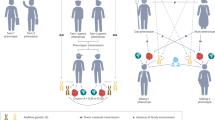Abstract
Behavioral geneticists sometimes use metaphorsto describe the role of genes in humanbehavior. In this paper, five sample texts areanalyzed: a popular book, a textbook, ascientific review article, and two originalscientific articles representing differentapproaches in behavioral genetics. Metaphorsare found in all the different kinds of sampletexts, not only in the popular book and thetextbook. This suggests that metaphors are usednot only for rhetorical or pedagogical purposesbut play a more fundamental role in scientificunderstanding. In the sample texts, themetaphors tend to be antideterministic, i.e.,they do not imply genetic determinism butstress the interaction of multiple genes andmultiple environmental factors. No conclusioncan be drawn, however, as to whetherantideterminism is representative ofpresent-day behavioral geneticists in general.Certain historically important metaphors thatmay imply genetic determinism are qualified,avoided, or explicitly rejected. There aretensions between some of the metaphors, makingthem difficult to combine. All the metaphorsthat are used appear empirically apt, howeversometimes only with certain qualifications.
Similar content being viewed by others
References
Lakoff G, Johnson M. Metaphors We Live By. Chicago: University of Chicago Press, 1980.
Avise JC. Evolving genomic metaphors: A new look at the language of DNA. Science 2001; 294(5540): 86–87.
Hamer D, Copeland P. Living With Our Genes: Why They Matter More Than You Think. London: Pan Books, 2000.
Plomin R, DeFries JC, McLearn GE, McGuffin P. Behavioral Genetics, 4th edn. New York: Worth Publishers, 2001.
McGuffin P, Martin N. Science, medicine, and the future: behaviour and genes. British Medical Journal 1999; 319(7201): 37–40.
Cardno AG, Marshall EJ, Coid B, MacDonald AM, Ribchester TR, Davies NJ, Venturi P, Jones LA, Lewis SW, Sham PC, Gottesman II, Farmer AE, McGuffin P, Reveley AM, Murray RM. Heritability estimates for psychotic disorders: The maudsley twin psychosis series. Arch. Gen. Psychiatry 1999; 56(2): 162–168.
Hamer DH, Greenberg BD, Sabol SZ, Murphy DL. Role of the serotonin transporter gene in temperament and character. Journal of Personality Disorders 1999; 13(4): 312–328.
Ridley M. Genome: The Autobiography of a Species in 23 Chapters. London: Fourth Estate, 1999.
Nelkin D, Lindee MS. The DNA Mystique. The Gene as a Cultural Icon. New York: W.H. Freeman and Company, 1995.
Jacob F, Monod J. Genetic regulatory mechanisms in the synthesis of protein. Journal of Molecular Biology 1961; 3: 318–356.
Keller EF. The Century of the Gene. Cambridge: Harvard University Press, 2000.
Collins English Dictionary, 4th edn. Glasgow: Harper Collins Publishers, 1999.
The Oxford English Dictionary, 2nd edn. Oxford: Clarendon Press, 1989.
Nordgren A. Responsible Genetics: The Moral Responsibility of Geneticists for the Consequences of Human Genetics Research, Philosophy and Medicine series Vol. 70. Dordrecht: Kluwer Academic Publishers, 2001.
Lakoff G, Johnson M. Philosophy in the Flesh: The Embodied Mind and Its Challenge to Western Thought. New York: Basic Books, 1999.
Rosch E, Lloyd BB, eds. Cognition and Categorization. Hillsdale: Lawrence Erlbaum, 1978.
Venter JC et al. The human genome: The sequence of the human genome. Science 2001; 291(5507): 1304–1351.
Bateson P, Martin P. Design for a Life: How Biology and Psychology Shape Human Behavior. New York: Simon & Schuster, 2000.
Author information
Authors and Affiliations
Rights and permissions
About this article
Cite this article
Nordgren, A. Metaphors in behavioral genetics. Theor Med Bioeth 24, 59–77 (2003). https://doi.org/10.1023/A:1022912918641
Issue Date:
DOI: https://doi.org/10.1023/A:1022912918641




